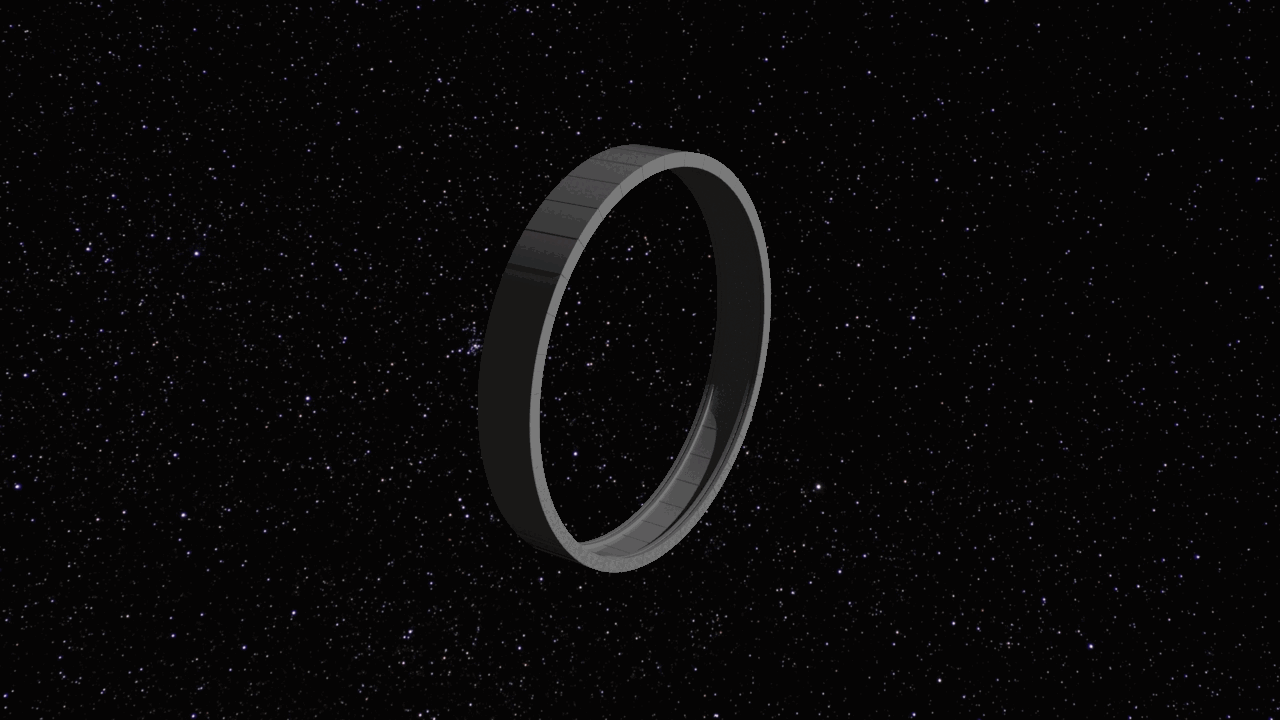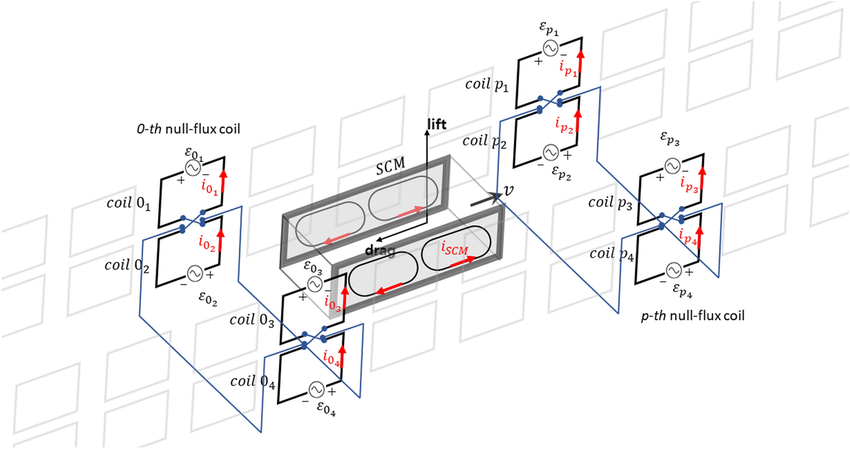Project Orbital investigates the possibility of rotating habitats of unlimited scale through structural decoupling.
Classification: R4iii <-> R9ix
Beyond the Limits - Arbitrarily Large Rotating Space Habitats through Structural Decoupling
IAC 2024 - Milan, Italy
Abstract:
Rotating space habitats have been a staple of space habitat design language since Tsiolkovsky's writings dating back to 1903. The notional conception of a rotating space habitat has a maximum theoretical size, which is due to the breaking length of the structural material. While this notional rotating space habitat concept has been universally assumed, it has a glaring design flaw: the structural mass contributes to the centrifugal weight. This flaw inherently limits the structural mass efficiency of the habitat and is solely responsible for the oft-cited maximum theoretical size. Although it might seem unavoidable, the limitations associated with this flaw are not intrinsic to the concept of rotating habitats and can be overcome. This study proposes a novel design solution: decouple the habitat and structure, enabling the habitat to function as a rotating inner ring encased within a static structural ring. By keeping the structural ring static, it need not resist the centrifugal force generated by its own mass, ensuring that the structural mass does not contribute to additional hoop stress. This research focuses on the application of superconducting magnetic levitation of the inner, rotating ring against the outer, static ring, thereby substantially diminishing the hoop stress on the outer ring. The core objective of this research is to validate the hypothesis that decoupling the rotating portion of the habitat from the support structure eliminates size constraints associated with rotating habitats and decreases the amount of structural material required. This validation is achieved through theoretical proofs as well as practical model experimentation, each of which illustrate the fundamental principles. Consequently, this allows for the construction of extremely large habitats using rudimentary materials, challenging the predominant view that advanced materials are necessary for such structures. Such a habitat would maintain additional benefits, such as kinetic energy storage and straightforward docking/berthing. The results of this research have immediate implications for reducing the structural mass of prospective rotating space habitat designs and opens possibilities for using common materials in large-scale habitat construction. Given these outcomes, the findings not only pave the way for more efficient and sustainable space habitat construction but also signal a pivotal shift in the field. This research lays the groundwork for a comprehensive re-evaluation of rotating habitat design, underscoring the need for further exploration in areas such as the development of orbital test beds for magnetic levitation, biological testing across different gravity levels, and comparative analyses of structural materials.
Conventional Rotating Habitats: Breaking Lengths and Inefficiencies
Rotating habitats have long been considered a promising method for simulating gravity in space through the application of centripetal acceleration. However, such designs are encumbered by a fundamental limitation: the structure must support its own centrifugal weight. As the habitat rotates to generate artificial gravity, the entire composite structure, including both habitat elements and structure, must resist the induced centrifugal forces of the entire rotating mass. This results in unnecessarily high hoop stress within the structural system.
The main challenge lies in scaling up a habitat, which necessitates increasing the structural thickness to withstand the greater stresses involved (according to the hoop stress equation). However, by increasing the structural thickness, the structural mass must necessarily increase in kind, which diminishes the benefit of more structure. In this way, each material has a breaking length—the maximum span a structure can sustain before the centrifugal weight itself exceeds its bearing capacity. This breaking length inherently restricts the size to which conventional rotating habitats can be expanded, irrespective of the material used.
The Innovation: Decoupling Structural from Habitat
The central innovation of this research lies in a decoupled structural design, wherein the external structural ring remains static, while only the internal habitat rotates to simulate gravity. By effectively removing the structural mass from the rotating assembly, the static shell ceases to contribute to centrifugal stress. This paradigm shift enables the circumvention of size limitations traditionally imposed by the breaking lengths of structural materials.
In this configuration, the habitat can achieve arbitrarily large dimensions, as the structural scale is no longer constrained by rotational stresses. Instead, the thickness of the static shell may be augmented independently to support larger habitats. This decoupling mechanism permits the use of widely available materials such as carbon fiber or stainless steel, obviating the necessity for advanced, speculative materials like graphene or carbon nanotubes.
Mitigating Counter-Rotation
One of the critical challenges presented by the decoupled design is the issue of counter-rotation. As the inner habitat rotates, it induces a reactionary force on the static shell, potentially causing undesirable counter-rotation in the outer structure that reduces the structural capacity of the outer structure. To mitigate this, various strategies have been explored to ensure that the outer shell remains static.
The primary method involves incorporating reaction control mechanisms that counteract the forces exerted by the rotating habitat. These mechanisms mayt include:
Reaction Propulsion of the Rotating Habitat: This method involves applying propulsion directly to the rotating habitat to spin it up and maintain its desired velocity.
Magnetic Propulsion of the Rotating Habitat: Magnetic forces are used to control and adjust the spin rate of the rotating habitat, often in combination with one or more of the following:
Thruster Propulsion: Thrusters are employed to mitigate any induced counter-rotation.
Mass Tethering: One or more masses are tethered to the outer structure of the structural ring, distributing the angular momentum between the structure and the tethered masses, thus dramatically reducing the angular velocity imparted to the outer ring.
Twinned Habitats: Constructing a connected twin rotating habitat that spins in the opposite direction to the first habitat, thereby balancing the rotational torques, preventing net counter-rotation.
These mitigation strategies are crucial for maintaining the stability and integrity of the decoupled system, ensuring that the benefits of structural decoupling are not compromised by the side-effect of counter-rotation.
Mechanism of Operation: Magnetic Levitation with Null Flux Coils
A significant technical challenge inherent in the decoupled system is enabling the inner habitat to rotate freely within the confines of the static shell. This differential motion is facilitated through magnetic levitation. In this design, the rotating habitat is suspended within the static structure without physical contact, thereby eliminating friction and reducing wear.
The research identifies null flux coils and superconducting magnetic coils as the most viable technologies for achieving stable levitation. When cooled to superconducting temperatures, these coils can provide the following:
Lift: Ensuring that the rotating habitat remains centered within the structural shell.
Guidance: Maintaining alignment and stability of the habitat throughout its operation.
Minimized Energy Consumption: Utilizing the vacuum of space to maintain the superconducting coils in an efficient, cooled state.
The implementation of magnetic levitation ensures that the rotating habitat remains stable and operational over extended durations with minimal maintenance requirements.
Experimental Validation: Small-Scale Model Demonstration
To substantiate the theoretical principles, a small-scale experimental model was constructed to demonstrate the decoupling mechanism through magnetic support. The experimental setup comprised two distinct conditions:
A control configuration, wherein the inner ring rotated independently, devoid of a static outer ring.
A test configuration, wherein the inner ring rotated within a static shell, simulating the decoupled system.
The results were promising: the inner ring attained a 13% increase in angular velocity under the decoupled configuration, corresponding to a 28% improvement in effective tensile strength. This empirical validation provides more than statistically significant evidence that decoupling the structural elements from the rotating habitat functions as intended.
Future Prospects: Constructing Larger and Sustainable Habitats
This research represents a pivotal advancement toward realizing large-scale space habitats. By employing a decoupled structural design, it becomes feasible to construct habitats on a scale previously deemed impracticable, utilizing materials that are readily accessible. This development unlocks novel opportunities for sustainable human habitation in space, encompassing orbital colonies and deep-space stations.
Future research will focus on:
Developing orbital test platforms to further evaluate magnetic levitation technology in extraterrestrial environments.
Investigating the long-term behavior of superconducting systems in the vacuum of space.
Conducting biological studies at varying levels of artificial gravity to better understand human adaptation to these environments.
The overarching objective remains to transcend the constraints of conventional design, thereby ushering in a new era of space habitats that are larger, more efficient, and more readily constructible.










